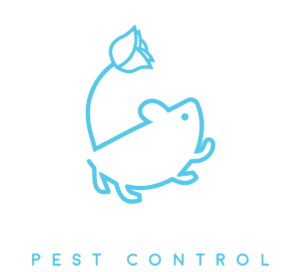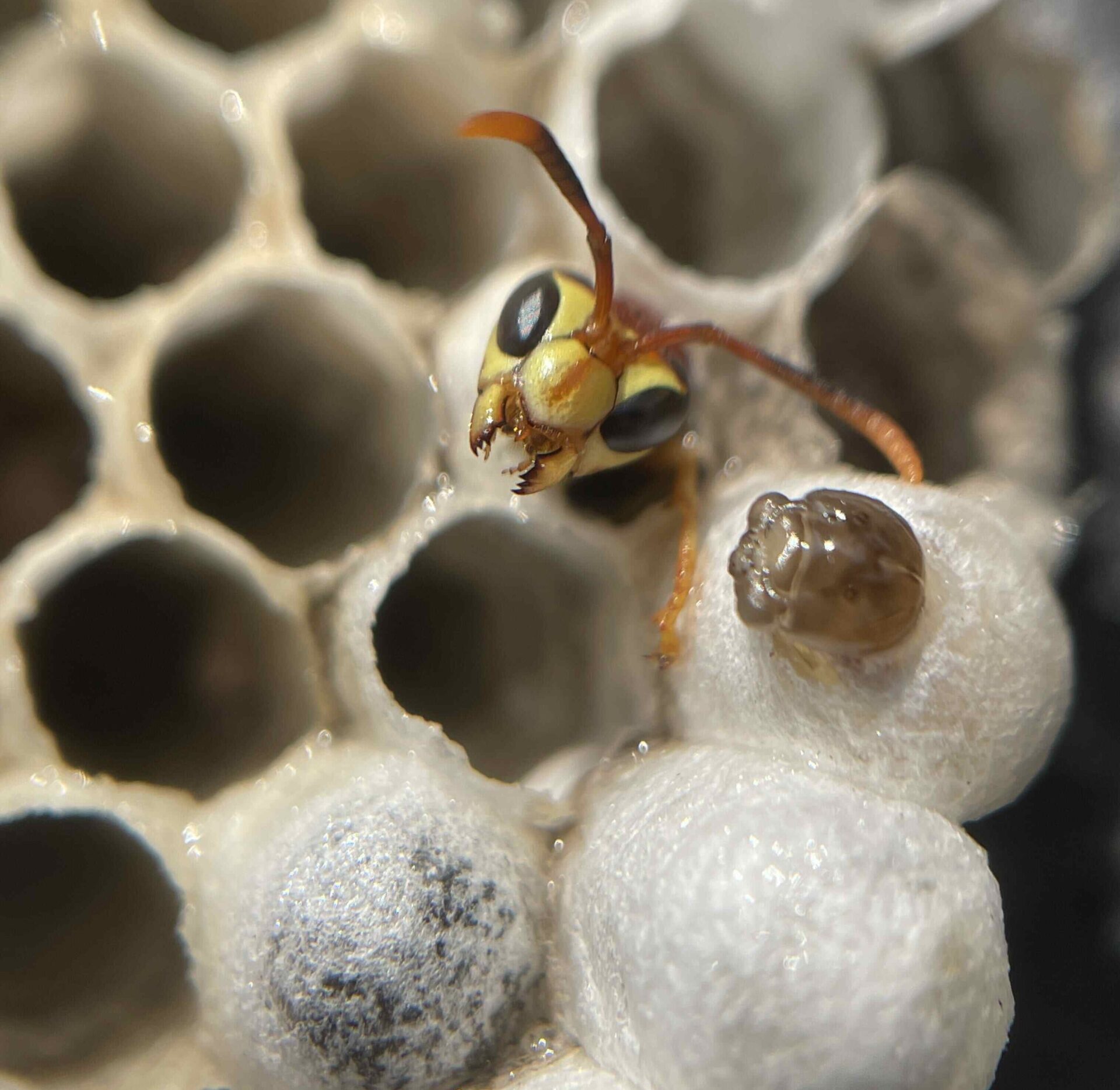Paper wasps follow a relatively straightforward annual cycle:
- Spring: Emergence of the Queen
In early spring, a mated queen paper wasp awakens from hibernation after surviving the winter in a sheltered location (like under bark or inside a wall). She begins searching for a suitable location to build her nest, often in high, sheltered spots like eaves, beams, or porch ceilings. - Nest Building
The queen constructs the initial cells of her paper nest by chewing plant fibers mixed with her saliva to create a papery material. This forms the base of the nest, which looks like an open, umbrella-shaped structure. - Egg Laying and Worker Development
After the queen lays her first batch of eggs, she stays busy expanding the nest while caring for the larvae that emerge. Once the larvae mature and pupate, they become adult worker wasps. These workers take over nest expansion, foraging, and caring for subsequent eggs, allowing the queen to focus on laying more eggs. - Mid-Summer: Colony Growth
By mid-summer, the colony reaches its peak with around 20–30 wasps. Unlike yellow jackets, paper wasp colonies are relatively small, and the wasps tend to be less aggressive unless directly threatened. - Late Summer to Fall: Reproduction
Toward the end of the summer, the queen starts laying eggs that develop into fertile males and new queens. Once these reproductive wasps mature, they leave the nest to mate. After mating, the new queens seek out a place to hibernate for the winter, while the original queen, workers, and males die off as temperatures drop.
Mud Dauber Wasp Life Cycle
Mud daubers are solitary wasps with a unique nesting process:
- Spring: Emergence of the Female
Similar to other wasps, female mud daubers emerge in spring after overwintering as adults in sheltered locations. They do not form colonies like paper wasps or yellow jackets; each female operates independently. - Nest Construction
Mud dauber wasps get to work building their characteristic nests made of mud. These nests resemble small tubes or clumps and are often found in sheltered spots such as under eaves, inside sheds, or on porch ceilings. The female collects mud in her mandibles, returning multiple times to create several cells within the nest. - Egg Laying and Provisioning
Once the nest is built, the female mud dauber lays one egg in each cell. She then hunts for spiders or small insects, stinging them to paralyze them rather than kill them. These paralyzed prey are placed in the cells as food for the developing larvae. The female then seals each cell with more mud. - Larval Development
The eggs hatch into larvae, which feed on the paralyzed insects provided by the mother. As they grow, the larvae pupate within their mud cells, spinning a cocoon inside to protect themselves as they develop into adult wasps. - Late Summer to Fall: Emergence of New Adults
Once the larvae have fully developed, they emerge from their mud cells as adult wasps, ready to repeat the cycle. In colder climates, mud daubers may overwinter as larvae and emerge the following spring as adults.
Yellow Jacket Life Cycle
Yellow jackets have a more complex and aggressive life cycle, particularly because they form large colonies:
- Spring: Emergence of the Queen
In the early spring, a mated queen yellow jacket emerges from hibernation, usually from a protected place like a log, under leaf litter, or even in an attic. The queen’s first task is to find a suitable nesting site, which could be underground in an abandoned rodent burrow, inside wall voids, or in dense bushes. - Initial Nest Building
The queen constructs a small, paper-like nest using chewed wood fibers. Unlike the small open cells of paper wasps, yellow jacket nests are enclosed in a papery shell. She then begins laying her first batch of eggs. - Worker Development
The queen initially tends to the larvae that hatch from the eggs, feeding them regurgitated food. After about a month, the first adult workers emerge, taking over the nest’s construction, defense, and foraging responsibilities. The queen now focuses solely on laying eggs. - Mid-Summer: Rapid Colony Expansion
Yellow jacket colonies can grow rapidly, especially during the mid-to-late summer when the worker population increases exponentially. At their peak, a yellow jacket colony can house several thousand wasps. These workers continue to expand the nest while foraging aggressively for food—especially proteins for the larvae and sugars for the adults. - Late Summer to Fall: Reproduction Phase
As the summer wanes, the queen begins laying eggs that develop into new reproductive males and queens. These new reproductives leave the nest to mate. After mating, the fertilized queens seek out protected locations to hibernate through the winter, while the rest of the colony, including the original queen, dies off as the weather cools. - Winter: Overwintering Queens
Fertile young queens enter a state of dormancy through the winter, hiding in sheltered places like bark, wall crevices, or underground burrows. Once spring arrives, the cycle begins again as the queens emerge to start new colonies.
By understanding the life cycles of paper wasps, mud daubers, and yellow jackets, you can take timely action to prevent them from becoming a problem around your home. Whether it’s spotting early nest development in spring or knowing when to expect an aggressive uptick in yellow jackets during late summer, being aware of their seasonal behavior is key to staying ahead of infestations.

